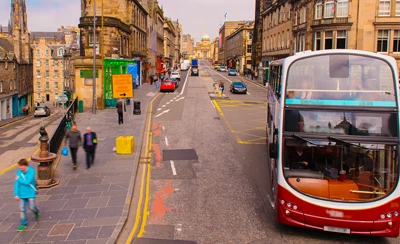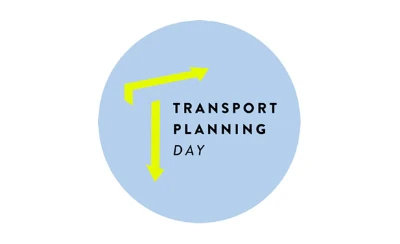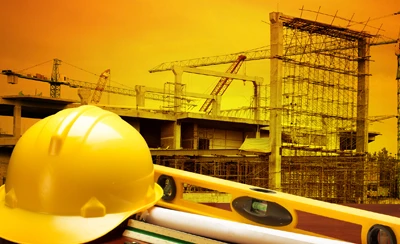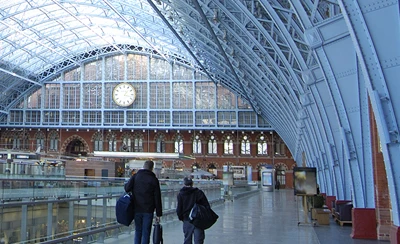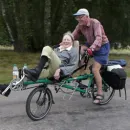Summary:
LTNs (Low Traffic Neighbourhoods) in Ealing have diverted scarce professional resources away from the more important task of establishing a borough cycling network which is safe, comfortable and well maintained.
Peter Mynors, Retired Transport Planner- formerly Director at Travers Morgan, then at Symonds Group Ltd
(This writing of this note has been prompted by the report “Pave the Way” by Transport for All, published January 2021)
There is no such being as the typical disabled person – each case is an individual one. My wife Angela has very limited walking ability, having been born with spinal problems. Outside the house she is reliant on either a wheelchair, a car, or a Pino tandem bicycle on the front of which she can pedal. Since she took up cycling at the age of 57 we have travelled together all over Europe on the Pino (or a prototype thereof), using the long distance cycle routes that exist there and are largely traffic free. Angela is now 81. We live in Ealing, on a street that is not within an LTN.
At the start of the first lockdown we had to cancel two planned expeditions to Europe with our Pino. But we then found that traffic levels in west London had plummeted. For the first time since we started tandem riding together we felt safe enough to start our regular exercise rides at our front door, rather than follow our previous regime of driving out of London for rides in Windsor Great Park. We have now ridden over 4000 km in west London since the first lockdown started.
What difficulties have we encountered? These are mostly the same as for normal cyclists, but we need more space to manoeuvre and when forced to dismount, it takes us longer to get moving again.
Poor road surfaces. Bad riding surfaces have accounted for well over half of all the scary moments we have had. Potholes, imperfect utility repairs and rutting create situations where one has to divert from one’s chosen line, sometimes at short notice. Our unpredictable behaviour can confuse motorists, to whom the reason for our erratic course is not usually obvious. If we actually hit a pothole it can cause Angela considerable pain as her back cannot accept the impact.
Traffic calming humps. Modern speed humps have a sinusoidal profile, which effectively slow down a car travelling at 20mph but do not cause difficulty to cyclists. There are however still many old-style round profile humps in existence, which are very uncomfortable for cycling over, particularly on the recumbent front seat of a tandem. We have now identified routes which do not have these old-style humps, and we deliberately stay away from those that still do.
Speed reduction cushions. These have not been recommended for use on cycle routes for a number of years, but there are still plenty around. Some have even been reinstated during recent road resurfacing. They can cause both cyclists and cars to take a sub-optimal path, and frequently make it hard for cyclists to “take the lane” when they should be doing so.
Together, humps and cushions probably account for a third of our difficult moments.
Motor traffic. This is normally the least of our worries. At the start of the pandemic when the roads were very empty, the occasional tear-away driver or motorcyclist did cause us a fright, but generally such cars were able to give us a wide berth. Our unusual bicycle has almost certainly resulted in above-average courtesy from drivers. However we suspect that the increasing numbers of bicycles on the road during the pandemic has also helped, as it has made drivers more aware of cyclists. More people have family members who cycle, so cyclists are better respected. The universal 20mph limit has also helped change attitudes.
How have LTNs affected us? The biggest single impact has been that they have absorbed much of the council’s scarce transport planning expertise. The previous cycling infrastructure programme has been largely put into suspense, rather than accelerated. The road closures that have actually been the most helpful (Mattock Lane, Olive Road) were already in the pipeline before covid, although both roads still have poor surfaces. Two other useful closures, Occupation Lane and Fishers Lane, are one-off point closures rather than full LTN schemes.
The largest LTN area (south of West Ealing) already included some low traffic routes created by existing point closures installed many years ago. We now have a better choice of low traffic routes through this area, but most of our exercise rides are undertaken on roads chosen because they are well surfaced and free of humps, not because LTNs have removed through traffic. Even within LTNs there is some residual access traffic, which can often block the road and force us to stop because the gap between the two rows of parked cars isn’t wide enough.
As well as LTNs there has been a limited programme of improving cycle lanes on major roads. This has helped us where the road surface is good enough, but in some instances the rows of wands push us uncomfortably close to the kerb, where gulleys and other ironwork make riding uncomfortable. One honourable exception has been The Vale in Acton, where the A4020 has been fully resurfaced and feels vastly safer for cycling than previously. This may well have already been in the programme before covid, as the surface here used to be particularly bad.
The main casualty of the pandemic has been that work appears to have ceased on defining the borough cycling network, which was one of the key proposals in the council’s Cycling Plan. Once this network has been defined, the roads included in it can be given priority for resurfacing and generally bringing up the LCDS (London Cycling Design Standards) requirements. This will replace the current apparently scattergun approach which often results in localised cycling measures that appear unrelated to each other.
The most useful achievement of the LTNs would seem to be the exclusion of longer distance traffic that has in recent years been directed through residential areas by satnavs and other digital aids such as Waze. However a better approach would have been to tackle this issue by adjusting the algorithms and databases used by the system providers, using legislation if this cannot be achieved voluntarily. The LTNs will also have persuaded some people to change mode away from car for short trips, but until the current lockdown ends we will not know whether the re-routing of the trips still being driven will cause unacceptable congestion on the main roads surrounding the LTNs. We are already finding it best to avoid cycling on some of these roads, as they begin to get clogged up by traffic jams but are too narrow to allow a cyclist to pass the jam.
To conclude, the new LTNs have not in themselves created areas in which we would now choose to ride. In Ealing many of the “easy win” closures had already been implemented. To be fair to the council, they had to follow the government’s pro-LTN policy and the consequential changes in TfL’s funding rules.
When the lockdowns end, it will be the poor road surfaces in our local area that persuade us to start driving to Windsor again for our rides, not the traffic. It would be wonderful if we could make the journey to Windsor by train; the rolling stock would easily accommodate our Pino. Sadly however the new lifts recently installed at Ealing Broadway station are slightly substandard – by only a few centimetres – and we would have great difficulty in getting the bike down to platform level.

